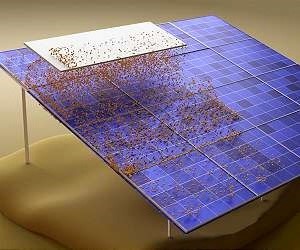Solar-powered adsorption cooling systems (SACS) have gained traction as a renewable energy technology that could provide clean power for air conditioning and refrigeration while significantly reducing the load on the electric grid. But these systems lack energy efficiency.
In the Journal of Renewable and Sustainable Energy, by AIP Publishing, researchers from Anna University in India developed an optimizer tool to design, evaluate, and maximize the performance of different types of SACS under various operating scenarios. The tool was created using Visual Basic programming language that is easy to learn and enables rapid application development.
“Our user-friendly optimizer is a multifunctional tool capable of designing and analyzing a complete solar powered adsorption refrigeration system,” co-author Edwin Mohan said. “Our tool is capable of assessing different combinations of operational parameters to determine the settings that maximize system performance.”
SACS, which work by turning solar energy into heat, consists of a sorption bed, condenser, liquid storage tank, expansion valve, and evaporator. At night, water or another refrigerant is vaporized through the evaporator.
During daylight hours, heat obtained from the sun causes the vapor to travel through the condenser, where it is reliquefied to release latent heat. The liquid eventually returns to the evaporator to repeat the process.
One of the most important elements of SACS is the pairing of materials used in the adsorption process in which atoms or molecules of a substance (the adsorbate) adhere to the surface of a porous material (the adsorbent), like activated carbon and zeolite, to maximize the surface-to-volume ratio.
In their study, the researchers used their computational tool to test two adsorbent/adsorbate pairs: activated-carbon and methanol, and zeolite and water. The experiments were carried out over four days in a prototype SACS with a cooling capacity of 0.25 kilowatts. They found the activated-carbon-methanol combination achieved a higher coefficient of performance, but the zeolite-water adsorption system could operate at higher temperatures.
The optimizer tool predicted the proper material mass concentration ratios. The method calculated the cooling load, predicted maximal performance, and conducted the overall performance analysis of the cooling system.
Although the study focused on residential home cooling systems, the researchers said their optimizer tool could be extended to higher capacity systems.
Research Report: “Optimization and experimental analysis of a solar-powered adsorption refrigeration system using selective adsorbent/adsorbate pairs”
Related Links
American Institute of Physics
All About Solar Energy at SolarDaily.com
|
We need your help. The SpaceDaily news network continues to grow but revenues have never been harder to maintain. With the rise of Ad Blockers, and Facebook – our traditional revenue sources via quality network advertising continues to decline. And unlike so many other news sites, we don’t have a paywall – with those annoying usernames and passwords. Our news coverage takes time and effort to publish 365 days a year. If you find our news sites informative and useful then please consider becoming a regular supporter or for now make a one off contribution. |
||
|
SpaceDaily Contributor $5 Billed Once credit card or paypal |
SpaceDaily Monthly Supporter $5 Billed Monthly paypal only |
|

![]()
How to clean solar panels without water
Boston MA (SPX) Mar 13, 2022
Solar power is expected to reach 10 percent of global power generation by the year 2030, and much of that is likely to be located in desert areas, where sunlight is abundant. But the accumulation of dust on solar panels or mirrors is already a significant issue – it can reduce the output of photovoltaic panels by as much as 30 percent in just one month – so regular cleaning is essential for such installations.
But cleaning solar panels currently is estimated to use about 10 billion gallons of wate … read more
